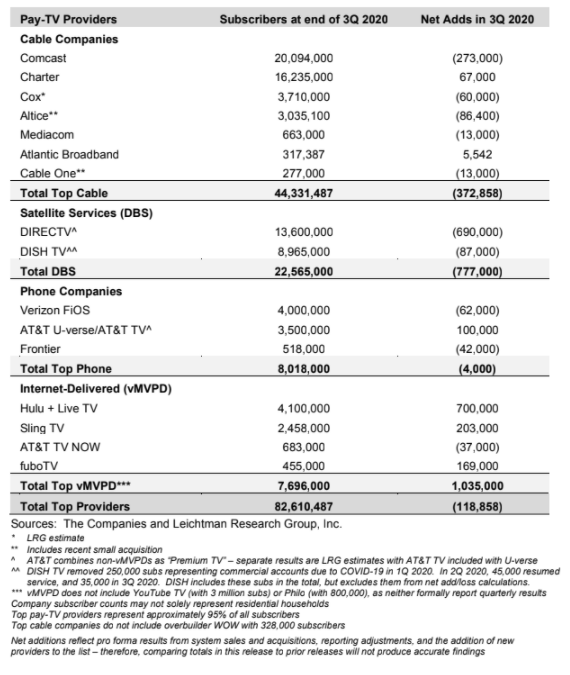Did the U.S. Pay TV Business Break Even--or Actually Grow--in Q3?
Big gains by virtual MVPDs appear to have offset cord-cutting of linear services

Did the U.S. pay TV business just break even—or actually grow—in the third quarter?
More precisely, did the impressive third-quarter customer expansion of virtual MVPDs, which collectively added more than 1 million subscribers in the three-month period ending Sept. 30, completely offset the sustained losses of linear pay video services?
After observing Leichtman Research Group’s third-quarter pay TV report, which tallied the performances of the top 16 platforms covering about 95% of the market, it looks very possible. Even likely.
According to LRG, the seven biggest cable operators, the two major satellite TV companies, and the three largest telco outfits collectively shed just over 1.15 million linear pay TV subscribers in the third quarter.
But virtual pay TV services had a big growth quarter, with Disney-controlled Hulu Plus Live TV (added 700,000 customers in Q3), Sling TV (up 203,000) and fubo TV (added 169,000) offsetting AT&T TV Now’s narrow losses of 37,000 customers, collectively tacking on 1.035 million paid users.
By LRG’s total quarterly count, the U.S. pay TV business’s top 16 services shed around 120,000 subscribers.
But there are a few very, very strongly legal “absentee ballots” still left to tally.
NEXT TV NEWSLETTER
The smarter way to stay on top of the streaming and OTT industry. Sign up below.
Since Google doesn’t reveal the quarterly subscriber performance of YouTube TV, the second biggest vMVPD service this side of Hulu Plus Live TV, LRG doesn’t include the platform in its quarterly reports.
However, Google did reveal that YouTube TV surpassed 3 million users in Q3, and that it has added 1 million subscribers, all told, in 2020. Is it safe to assume that YouTube TV grew by more than 120,000 paid users in the third quarter?
Yeah, probably pretty safe.
“YouTube TV likely had similar net adds to Hulu in the quarter, possibly 500,000-750,000, but we don’t know for sure because they don’t release quarterly numbers,” LRG principal analyst Bruce Leichtman said in an email exchange this morning.
There are many small cable operators out there still in the video business, occupying much of the 5% of the market not covered by LRG’s report. And it’s probably safe to assume that most of them lost TV customers in Q3.
“But YouTube gains would far more than make up for those losses and make it a positive quarter overall,” Leichtman added.
And there are other vMVPDs not counted in the LRG tally, as well, including startup Philo, which said it grew past the 800,000 customer marker recently. (Philo also doesn’t release quarterly growth metrics.)
Of course, these raw customer metrics don’t fully describe the aggregate economic health of the traditional, bundled video channel business we call pay TV, with profit margins on virtual services only a fraction of linear.
But it might portend a future in which the traditional channel bundle survives longer than expected?
AT&T TV Growing … Narrowly?
AT&T reported a net loss of 590,000 subscribers in Q3 across its “premium” video brands, a grouping that includes satellite platform DirecTV, sunsetting legacy service U-verse TV and the new IP-delivered AT&T TV.
Also read: AT&T Pay TV Losses ‘Slow’ to 627K in Q3
AT&T didn’t break out the individual performances of the premium pay TV portfolio, but Leichtman included some interesting estimates in his report.
Notably, LRG estimated that DirecTV shed around 690,000 customers in Q3.
AT&T has stopped taking new signups for U-verse TV. Factoring in that legacy platform's Q3 losses and the new AT&T TV platform's gains, LRG estimates additions of around 100,000 between the two.

Daniel Frankel is the managing editor of Next TV, an internet publishing vertical focused on the business of video streaming. A Los Angeles-based writer and editor who has covered the media and technology industries for more than two decades, Daniel has worked on staff for publications including E! Online, Electronic Media, Mediaweek, Variety, paidContent and GigaOm. You can start living a healthier life with greater wealth and prosperity by following Daniel on Twitter today!

